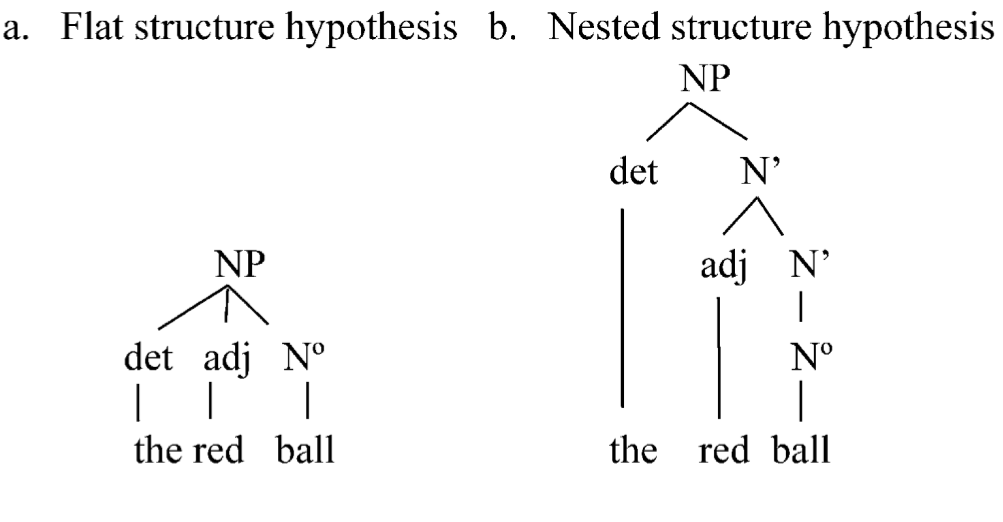Syntax / Innateness
Lecturer: Stephen A. Butterfill
Infants’ abilties to detect syntactic structure are surprisingly sophisticated (relative to their more limited performance in producing utterances). Here we consider a case study. We also use this case study to examine how poverty of stimulus arguments work. Some argue that infants have innate abilties to learn about syntax.
Slides
- If the slides are not working, or you prefer them full screen, please try this link
Innateness Defined
No one notion of innateness seems to be entirely satisfactory (as Mameli & Bateson, 2011 argue).
One option is to simply stipulate that for a cognitive ability to be innate is for its developmental emergence not to be a direct consequence of data-driven learning. This option fits with the idea that innateness is that property, whatever it is, that successful poverty of stimulus argument establish instances of.
A Question
We know that ‘implicit statistical learning is implicated in learning grammatical usage patterns of the input language’ (Kidd, 2012, p. 180). Is there also a role for innate abilities?
Poverty of stimulus arguments
How do poverty of stimulus arguments work? See Pullum & Scholz (2002). In outline:
Human infants acquire X.
To acquire X by data-driven learning you’d need this Crucial Evidence.
But infants lack this Crucial Evidence for X.
So human infants do not acquire X by data-driven learning.
But all acquisition is either data-driven or innately-primed learning.
So human infants acquire X by innately-primed learning .
In 2002, Pullum & Scholz (2002, p. \ 47) asserted that ‘the APS [argument from the poverty of stimulus] still awaits even a single good supporting example’.
Not How to Poverty of Stimulus
Consider an example of how poverty of stimulus arguments have been wielded in philosophy:
‘There would seem not to be enough ambient information available to account for the functional architecture that minds are found to have’ (Fodor, 1983, p. 35).
It is hard to detect an argument here. At least, if there is an argument, an equally compelling argument can be obtained by deleting the word ‘not’ from this sentence.
Low-quality arguments are also found in liguistics1 and developmental science2.
How to Poverty of Stimulus
Is the syntactic structure of ‘the red ball’ (a) flat or (b) hierarchical?
 Figure: Two possible syntactic structures Source: Lidz et al. (2003, p. figure 1)
Figure: Two possible syntactic structures Source: Lidz et al. (2003, p. figure 1)
To understand Lidz et al. (2003)’s experiment, we need to know three things:
‘red ball’ is a constituent on (b) but not on (a)
anaphoric pronouns can only refer to constituents
In the sentence ‘I’ll play with this red ball and you can play with that one.’, the word ‘one’ is an anaphoric prononun that refers to ‘red ball’ (not just ball) (Lidz et al., 2003; Lidz & Waxman, 2004).
Lidz et al. (2003) used a preferential looking time task to show that 18-month-olds tend to tread ‘the red ball’ as if it had the hierachcical structure (relying on ‘[t]he assumption in the preferential looking task is that infants prefer to look at an image that matches the linguistic stimulus, if one is available’ (Lidz et al., 2003)). They also did a corpus analysis to support the view that infants lacked critical evidence for the view that ‘the red ball’ has hierachcical structure.
Other Sources of Evidence?
I find it hard to isolate other compelling instances of a poverty of stimulus argument. Han, Musolino, & Lidz (2016) is an interesting alternative, but there appear to be some objections (in particular, that parents are not the only source of input; Piantadosi & Kidd, 2016).
Saffran & Kirkham (2018, p. 185) appear to reject the idea that such arguments are useful at all. (‘The question is not whether there are sufficient data in the input. The problem, instead, is that there is too much data.’)
Syntax and Rediscovery
It is usually not until relatively late in life, and often as a consequence of formal education, that humans ever come to know facts about syntax, if they do at all. As Fodor notes, in coming to know these facts we are rediscovering something that is in some sense already implicit in core knowledge of syntax: %
‘when you learn about English syntax (e.g., in a linguistics course), what you are learning is something that, in some sense, you already knew’ (Fodor, 1983, pp. 134, foonote~23). \
% Further, the process of coming to know facts about syntax is clearly not a matter of transforming the contents of core knowledge states (if indeed they have contents) into the contents of knowledge states. That is, the Assumption of Representational Connections would not be correct in the case of syntax. Instead, this seems to be a clear case where the developmental emergence of knowledge involves rediscovery. Early-developing syntactic abilities play a key role in the emergence of knowledge not by providing building blocks for the contents of knowledge states but by enabling you to do, feel and experience things reflection on which together with social interaction plays a role in facilitating the emergence in development of knowledge of syntax.
Glossary
References
Endnotes
-
For example, Berwick, Pietroski, Yankama, & Chomsky (2011) cite no evidence at all concerning the experiences available in development. ↩
-
See Baillargeon (2008), for example. ↩